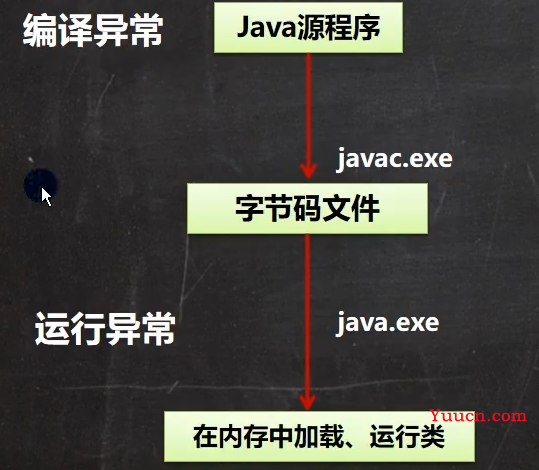异常
一、基本介绍
-
基本概念:
Java语言中,将程序执行中发生的不正常情况称为 “异常”。(开发过程中的语法错误和逻辑错误不是异常)
-
执行过程中所发生的异常事件可以分为两类
- Error(错误):Java虚拟机无法解决的严重问题。如:JVM系统内部错误、资源耗尽等严重情况。比如:StackOverflowError[栈溢出] 和 OOM(out of memory),Error是严重错误,程序会崩溃。
- Exception:其他因编程错误或偶然的外在因素导致的一般性问题,可以是使用针对性的代码进行处理。例如空指针访问,试图读取不存在的文件,网络连接中断等等,Exception 分为两大类:运行时异常和编译时异常。
-
异常体系图一览


- 异常体系图小结:
- 异常分为两大类,运行时异常和编译时异常。
- 运行时异常,编译器检查不出来。一般是指编程时的逻辑错误,是程序员应该避免其出现的异常。java.lang.RuntimeException类及它的子类都是运行时异常。
- 对于运行时异常,可以不做处理,因为这类异常很普遍,若全处理可能会对程序的可读性和运行效率产生影响。
- 编译时异常,是编译器要求必须处置的异常。
- 异常体系图小结:
二、运行时异常
-
常见的运行时异常
-
NullPointerException 空指针异常
当应用程序试图在需要对象的地方使用 null 时,抛出该异常。
-
ArithmeticException 数字运算异常
当出现异常的运算条件时,抛出此异常。例如,一个整数除以零时,就会抛出此类的一个实例。
-
ArrayIndexOutOfBoundsException 数组下标越界异常
用非法索引访问数组时抛出的异常。如果索引为负或大于等于数组大小,则该索引为非法索引。
-
ClassCastException 类型转换异常
当试图将对象强制类型转换为不是实例的子类时,抛出该异常。
-
NumberFormatException 数字格式不正确异常
当应用程序试图将字符串转换成一种数值类型,但该字符串不能转换为适当格式时,抛出该异常。
-
三、编译时异常
- 介绍:编译异常是指在编译期间就必须处理的异常,否则代码不能通过编译。
- 常见的编译异常
- SQLException:操作数据库时,查询表可能发生异常
- IOException:操作文件时,发生的异常
- FileNotFoundException:当操作一个不存在的文件时,发生异常
- ClassNotFoundException:加载类,而该类不存在时,异常
- EOFException:操作文件,到文件末尾,发生异常
- IllegalArguementException:参数异常
四、 异常处理机制
-
基本介绍
异常处理就是当异常发生时,对异常处理的方式 -
异常处理的方式
-
try-catch-finally
程序员在代码中捕获发生的异常,自行处理

-
throws
将发生的异常抛出,交给调用者(方法)来处理,最顶级的处理者就是JVM。
在异常抛至JVM时,JVM会先输出异常信息,然后退出程序。

-
- 对于运行时异常,如果程序员没有显式处理异常,默认throws的处理;
- 对于编译异常,程序中必须处理,比如try-catch 或 throws;
五、 try-catch 异常处理
-
try-catch 方式处理异常说明
-
Java 提供 try 和 catch 块来处理异常。try块用于包含可能出错的代码,catch块用于处理try块中发生的异常。可以根据需要在程序中有多个try-catch块。
-
基本语法
try{ //可疑代码 //将异常生成对应的异常对象,传递给catch块 }catch(异常){ //对异常的处理 }finally{ //一定被执行的语句 } //如果没有finally,语法也可以通过
-
-
try-catch 方式处理异常——注意事项
-
如果异常发生了,则异常发生后面的代码就不会执行,直接进入到catch块中。
-
如果异常没有发生,则顺序执行try的代码块,不会进入到catch。
-
如果希望不管是否发生异常,都执行某段代码(比如关闭连接,释放资源等)则使用如下代码:finally{ };
public class TryCatchDetail {
public static void main(String[] args) {
//1. 如果try中出现异常后,异常代码后的语句不会再执行,直接进入catch代码块
//2. 如果异常没有发生,则顺序执行try的代码块,不会进入到catch
//3. 如果希望不管是否发生异常,都执行某段代码(比如关闭连接,释放资源等)则使用如下代码 -finally
try {
String str = "韩顺平";
int a = Integer.parseInt(str);
System.out.println("数字:" + a);
} catch (NumberFormatException e) {
System.out.println("异常信息 = " + e.getMessage());
}finally {
System.out.println("finally代码块被执行...");
}
System.out.println("程序继续...");
}
}4. 可以有多个catch语句,捕获不同的异常(进行不同的业务处理),要求父类异常在后,子类异常在前,比如(Exception 在后,NullPotinterException 在前),如果发生异常,只会匹配一个catch,案例如下: ```java public class TryCatchDetail02 { public static void main(String[] args) { //1. 如果try代码块有可能有多个异常 //2. 可以使用多个catch 分别捕获不同的异常,相应处理(一次只能捕获到一个异常,多个catch是为了应对不同情况) //3. 要求子类异常写在前面,父类异常写在后面 try { Person person = new Person(); person = null; System.out.println(person.getName());//NullPointerException int n1 = 10; int n2 = 0; int res = n1/n2;//ArithmeticException } catch (NullPointerException e){ System.out.println("空指针异常 = " + e.getMessage()); }catch (ArithmeticException e){ System.out.println("算术异常 = " + e.getMessage()); }catch (Exception e) { e.printStackTrace(); } finally { } } } class Person{ private String name = "jack"; public String getName(){ return name; } } //运行结果:空指针异常 = null-
可以进行try-finally 配合使用,这种用法相当于没有捕获异常,因此程序会直接崩掉/退出。应用场景:就是执行一段代码不管,否发生异常,都必须执行某个业务逻辑
public class TryCatchDetail03 { public static void main(String[] args) { //可以进行try-finally 配合使用,这种用法相当于没有捕获异常 //因此程序会直接崩掉/退出。应用场景:就是执行一段代码不管,否发生异常 //都必须执行某个业务逻辑 try { int n1 = 10; int n2 = 0; System.out.println(n1/n2); } finally { System.out.println("执行了finally..."); } System.out.println("程序继续执行..."); } }
-
六、 throws 异常处理
-
基本介绍
- 如果一个方法(中的语句执行时)可能生成某种异常,但是并不能确定如何处理这种异常,则此方法应显示地声明抛出异常,表明该方法将不对这些异常进行处理,而由该方法的调用者负责处理。
- 在方法声明中用throws语句可以声明抛出异常的列表,即可以抛出多个异常,throws关键字后面的异常类型可以是方法中产生的异常类型,也可以时它的父类。
import java.io.FileInputStream; import java.io.FileNotFoundException; public class Throws01 { public static void main(String[] args) { } //4. throws后面的异常类型可以是方法中产生的异常,也可以是该异常的父类 public void f2() throws FileNotFoundException,NullPointerException {//或者写 throws Exception //创建了一个文件流对象 //1. 这里的异常是一个FileNotFoundException 编译异常 //2. 可以使用前面的try-catch-finally //3. 也可以使用throws,抛出异常,让调用f2方法的调用者处理 //5. throws 关键字后面也可以是 异常列表,即可以抛出多个异常 FileInputStream fis = new FileInputStream("d://aa.txt"); } } -
注意事项和使用细节
- 对于编译异常,程序中必须处理,比如try-catch 或 throws;
- 对于运行时异常,如果程序员没有显式处理异常,默认throws的处理;
- 子类重写父类方法时,对抛出异常的规定:子类重写的方法,所抛出的异常类型要么和父类抛出的异常一致。要么为父类抛出异常类型的子类型
- 在throws 过程中,如果有方法 try-catch,就相当于处理异常,就可以不必throws
import java.io.FileInputStream;
import java.io.FileNotFoundException;
/**
* @author
* @version 1.0
*/
public class ThrowsDetail {
public static void main(String[] args) {
f2();
}
public static void f2()/* throws ArithmeticException*/{
//1. 对于编译异常,程序中必须处理,比如try-catch 或 throws
//2. 对于运行时异常,程序中如果没有处理,默认就是throws的处理
int n1 = 10;
int n2 = 0;
double res = n1/n2;
}
public static void f1() throws FileNotFoundException{
//如果无 throws FileNotFoundException,则f3()调用报错
//f3()方法将编译异常抛给了调用者f1()
//编译异常必须处理,运行异常默认上抛
//这时就要f1()必须处这个编译异常
//在f1()中要么try-catch,要么继续上抛
f3();
}
public static void f3() throws FileNotFoundException {
FileInputStream fis = new FileInputStream("d://aa.txt");
}
public static void f4(){
//这里调用没有问题
//就算f5()有抛出的是运行异常
//而Java中运行异常并不要求程序员显示处理,因为有默认处理机制,会自动继续上抛
f5();
}
public static void f5() throws ArithmeticException{}
}
class Father{//父类
public void method() throws RuntimeException{
}
}
class Son extends Father{//子类
//3. 子类重写父类方法时,对抛出异常的规定:子类重写的方法
//所抛出的异常类型要么和父类抛出的异常一致。要么为父类抛出异常类型的子类型
//4. 在throws 过程中,如果有方法 try-catch,就相当于处理异常,就可以不必throws
@Override
public void method() throws ArithmeticException {
}
}
七、 自定义异常
-
基本概念
当程序中出现了某些 “错误”,但该错误信息并没有在Throwable子类中描述处理,这个时候可以自己设计异常类,用于描述错误信息。
-
自定义异常的步骤
- 定义类:自定义异常类名(程序员自己写)继承Exception或RuntimeException
- 如果继承Exception,属于编译异常
- 如果继承RuntimeException,属于运行异常(一般来说,继承RuntimeException)
-
案例:
public class CustomException { public static void main(String[] args) { int age = 180; //要求范围在18 - 120 之间,否则就抛出一个自定义的异常 if(!(age >= 18 && age <= 120)){ //这里可以通过构造器,设置信息 throw new AgeException("年龄需要在18 - 120岁之间"); } System.out.println("你的年龄范围正确"); } } //自定义一个异常 //1. 一般情况下,我们自定义异常是继承 RuntimeException //2. 即把自定义异常做成 运行时异常,好处是我们可以使用默认的处理机制,比较方便 class AgeException extends RuntimeException{ public AgeException(String message){ super(message); } }
八、 throw 和 throws 的区别
| 意义 | 位置 | 后面跟的东西 | |
|---|---|---|---|
| throws | 异常处理的一种方式 | 方法声明处 | 异常类型 |
| throw | 手动生成异常对象的关键字 | 方法体中 | 异常对象 |